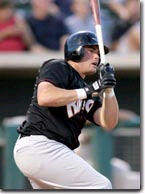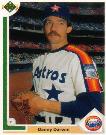
In 2003, Michael Lewis wrote a book designed to incite a vehement counter-reaction from traditional baseball thinkers. To do this, Lewis occasionally had to overstate the greatness of Billy Beane.
In 2006, Richard Van Zandt wrote an article designed to illustrate the over-hype surrounding Billy Beane’s greatness. To do this, Van Zandt occasionally had to overstate Beane’s failures in the 2002 draft.
I am fortunate to take the easily defensible middle ground, much as Scott has done with Derek Lowe. It is my opinion that Billy Beane’s draft philosophies are indeed revolutionary and incredibly effective, but that they are not necessarily the only sensible way to approach baseball scouting as Lewis appears to suggest.
 | |
| Colamarino: Worth the risk |
First off, while judging a draft’s success by determining how many players in that draft made the majors is probably the most judicious evaluation possible at this time, it is by no means flawless. For example, pointing out that Jason Bergmann made it to the majors before Brant Colamarino does not mean that Bergmann was a better pick. Colamarino has shown upside…huge upside…already in the minors. Bergmann was a middle reliever in the minors. Middle relievers in the minors almost never make it to the big leagues. Bergman did so only as a September callup for a team whose owners did not want them to reach the postseason, and his ceiling is being the 12th man on the pitching staff. Even if Colamarino never does make the majors, he represents a better draft choice than Bergmann because Brant at least had the potential to be an impact player at the major league level.
In a similar situation, Eric Reed has shown next to nothing
offensively in the minors, but made it big simply because the Marlins featured
one of the largest garage sales ever this offseason. Even as depleted as
Another thing to remember when evaluating draft picks is that scouting is only part of a farm system’s composition. The other is development. Luke Hagerty and Bobby Brownlie, both pitchers whom the A’s coveted in the 2002 draft, wound up in the Cubs organization instead. Pitchers in the Cubs organization get injured. Like players performing well during contract years, it’s just one of those facts of baseball. We can safely surmise that had these guys not been drafted by the Cubs, one if not both would not have suffered career-threatening injuries in the minors and be middle-of-the-rotation major leaguers today. Billy Beane was not unique in liking these guys. Everybody liked them, as they were both rated among the top ten players in the Cubs’ then-stacked system just after being drafted.
And as much as those two college pitchers have failed, there’s still no comparison to the failures of pitchers drafted out of high school. While Beane certainly hasn’t shown a predilection towards drafting position players out of high school, he is nowhere near as set against doing so as he is with drafting high school pitchers. Using Richard’s methodology in evaluating the high school pitchers taken in the 2002 draft, we find that only 3 out of 8 have made it big so far. One of those three is Zach Greinke, whose career ERA rests at 4.99 until his psychological examinations are completed and he is taken off of the 60-day DL. I don’t see any reason to question Beane’s reluctance to grab high school pitchers in the first round.
Nor do I see any reason to doubt the quality of Beane’s overall drafting policies. Clearly, they are revolutionary in that it is an approach that no other team had taken beforehand. Clearly, this is an effective approach for small-market teams who might wind up with multiple first round picks.
Now, I won’t say that it’s never a good idea to draft high school players in the first round. I’m sure Beane himself regrets trading away 2001 high school pick Jeremy Bonderman away to the Tigers for very small dividends. There may, in fact, be scouting departments out there who do have the knack for evaluating high school talent far enough above the average success rate. There may be minor league systems out there with a particular ability to develop high school pitchers into productive players. These are possibilities worthy of research.
Beane, I think, simply did not trust his 2002 scouting department, nor his own evaluation abilities to gauge which of the relatively small percent of high school pitchers will in fact make it. This shows a certain amount of humility on his part. However, Beane may be gaining in such confidence as evidenced by his drafting three high school pitchers within the first three rounds of last year’s draft.
In the end, you can’t fault Billy Beane for trying something different, and you shouldn’t fault Michael Lewis for applauding it. Time will ultimately tell precisely how successful Beane’s drafting methods are, but for now we do know that they are effective and that they are still being refined. I hope that in 2013, when Beane’s methods are perfected, that some enthusiastic writer chronicles the success and proliferation of the Moneyball system as entertainingly as Michael Lewis has.
|
Become A Sponsor of BaseballEvolution.com Sponsor a page at BaseballEvolution.com. On a page of your choice, you can place a personalized message, a tribute to a player, or a link to your website! |
